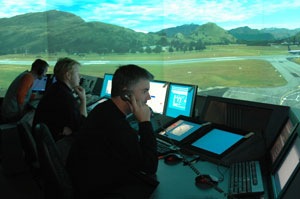Air Traffic Controller
Tasks & duties

Air traffic controllers may do some or all of the following:
-
receive information about flights from flight plans, pilot reports, radar and observations
-
direct aircraft and manage aircraft traffic flows
-
advise pilots on weather conditions, the status of facilities and airports
-
give pilots permission to take off, land, and change altitude and direction
-
give airport workers permission to move around the tarmac and runway
-
monitor aircraft in the air on a radar and look for possible conflicts
-
check equipment used for navigation
-
communicate by telephone, radio and datalink (satellite communication system) with pilots, air traffic controllers and other airport professionals
-
alert airport fire crew and rescue services in cases of emergency
-
write reports on incidents
Specialisations
Aerodrome Controller
Aerodrome controllers work at airport control towers.
Approach Radar Controller
Approach radar controllers handle aircraft as they arrive and as they depart from the airport.
Area Radar Controller
Area radar controllers control air traffic by radar.
Oceanic Controller
Oceanic controllers are responsible for all traffic in the Auckland Oceanic Flight Information Region. This region starts about 200 nautical miles offshore and extends to French Polynesia and Fiji, and halfway to Australia.
Skills & knowledge

Air traffic controllers need to have:
-
knowledge about flight planning and navigation
-
knowledge of technical flying terms
-
knowledge of different methods used to separate aircraft in the air
-
organisational skills and the ability to prioritise, plan and make decisions
-
the ability to solve problems quickly and effectively in a busy work environment
-
skill in interpreting information
-
understanding of civil aviation laws
-
an understanding of safety rules and emergency procedures
-
good spatial skills
-
a good short-term memory
-
skill in making calculations
-
communication skills and the ability to work well with others
Entry requirements
To become an air traffic controller you need to complete the Diploma in Air Traffic Control run by Airservices Australia. To be accepted into the course you need to be either a Australian citizen or a permanent resident. You must also pass written and computer-based aptitude tests, interviews and group exercises.
While you must be at least 20 years old to start the course, Airservices accepts applications from younger applicants who will be offered a place on the training course once they are of age.
Secondary education
There are no specific secondary education requirements for air traffic controllers, but maths and physics are helpful subjects to study.
Tertiary education
To become an air traffic controller you need to complete the Diploma in Air Traffic Control. Airservices Australia is the sole provider of this training in Australia.
Training on the job
Once you have completed the Airservices training course, you must undertake practical experience before becoming fully qualified. The length of the on-the-job training varies depending on where you are placed and what sort of traffic density you deal with, but usually takes between four and nine months.
The training qualifies air traffic controllers for aerodrome control or aerodrome and procedural approach control. To move into radar controlling requires further training. To work as an air traffic controller you also need to have a current Class 3 medical certificate and obtain airport security clearance.
Useful experience
Experience as an aeroplane pilot can be helpful for air traffic controllers, as can aviation and navigation experience. Air traffic controllers spend a lot of time dealing with pilots and other air traffic controllers, so any work involving people is useful.
Related courses
Air Traffic Control
For more information, please refer to myfuture.
Document Actions
